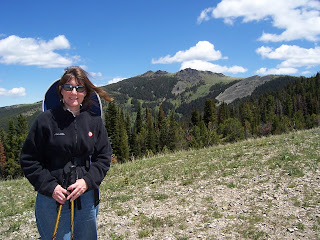 |
| One of the many, tough Tenderfoot crossings |
 |
| On the upper reaches of Tenderfoot Creek |
 |
| Nearing the top of Mount Wood |
We really weren’t looking for a tough workout when we set out to climb a couple of remote mountains (Wood, elevation: 7,525 feet) and Reynolds (7,175 feet) south of Tenderfoot Creek Saturday, but we got that workout nonetheless.
We were foolish enough to think these Little Belt peaks were easily gotten from this wild creek on the west side of the range. So, we didn’t carry topo maps, but relied on the rough Jefferson Division map from the Lewis and Clark National Forest.
This area has been discussed off and on as a wilderness candidate. The creek is a main feeder stream into Smith River. The access is tricky and tough any way you approach it. I’ve usually come into the Tenderfoot by way of the Taylor Hills Trail off Divide Road not far from Pilgrim Mountain. Last year I discovered it was more than a 2,000 foot drop into the creek with the attendant 2,000 foot return in very steep country.
This is ranching country and there’s been some mining here. In spots the ATVers and motorcyclists “own” it. Fishing is great from top to bottom. So’s the hunting if you can get permission to enter this land to retrieve your elk. If you’re lucky enough not to encounter one of the motorheads you will have as wild an experience as you can get.
That’s what we had last weekend.
We entered this country by way of the Sheep Creek Road south of Kings Hill Pass and at Eagle Park picked up a single track to a gate at Reynolds Park, where camas was in full bloom in the wetlands. We easily found the public land along Urvi Creek, skirted the private land and found a great game trail that dropped us steeply (600 feet) into Tenderfoot Creek where Balsinger Creek comes in.
We knew that the main Tenderfoot Creek Trail No. 342 was across the creek. I thought we had it made if we could get across the creek to that trail because I hadn’t carefully studied the map, which shows multiple creek crossings along our route.
 |
| Lots of debris on this trail, like this dead motorcycle |
Because of the abundant rain the creek was swollen. We stripped off our boots and put on sandals and clogs for the frozen wade. The force of the rushing water made the crossing somewhat treacherous. We steadied ourselves with our hiking sticks.
I still tingle when I think of that first crossing.
To make a long story short we found ourselves crossing the creek 10 times between Balsinger and just beyond the Taylor Hills trail junction (about 3 miles) where we began our climb. I gave up on the clogs and left on my leather boots because their support lent some safety to our task.
This was exhilarating.
The Tenderfoot winds its way through a steep volcanic canyon here. It is also heavily forested. The scenery as well as the cold creek was breathtaking.
The trail hasn’t been cleared in some time and it added to the wild nature of this hike.
While we enjoyed this experience, it wasn’t what we had come for --- we were after a couple of high mountains.
The crossings took the spring out of steps and gobbled lots of time. We made less than a mile an hour along this stretch of Tenderfoot. Along the way we passed some unexplainable heavy mining equipment on the trail, an old miners shack and a dead motorcycle, testament to this area’s ruggedness.
About a half mile beyond the Taylor Hills junction we recrossed the Tenderfoot and head up the flank of Wood peak, some 2,500 feet above us. We traveled through a forest of pencil-thin and densely spaced lodgepoles with lots of tree debris at foot.
We found our ridgeline and two hours later were atop the tree-covered Woods anticipating Reynolds.
Reynolds is a long, narrow pile volcanic talus.
Getting off Reynolds and back to our car would be tricky because most ridgelines dump you back down into the Tenderfoot. We knew we had to stay on the ridgeline back to the one-track road or sidehill across Reynolds to reach it.
After a small false start down toward the Tenderfoot we found a good packers trail that eventually led us through a large clearcut and then down to Reynolds Park.
When the trees cleared we could see this magnificent country clearly on this bright day.
There were the Crazy, Castle, Big Belt (Edith and Baldy peaks), Bridgers, Gallatins, and Absaroka ranges on the horizon.
We figured we had gained more than 4,000 feet going up and down ridgelines, a respectable day for any mountain range.
We had also gained a deep respect for this Tenderfoot country, more convinced than ever that its wild character merits wilderness protection.

















